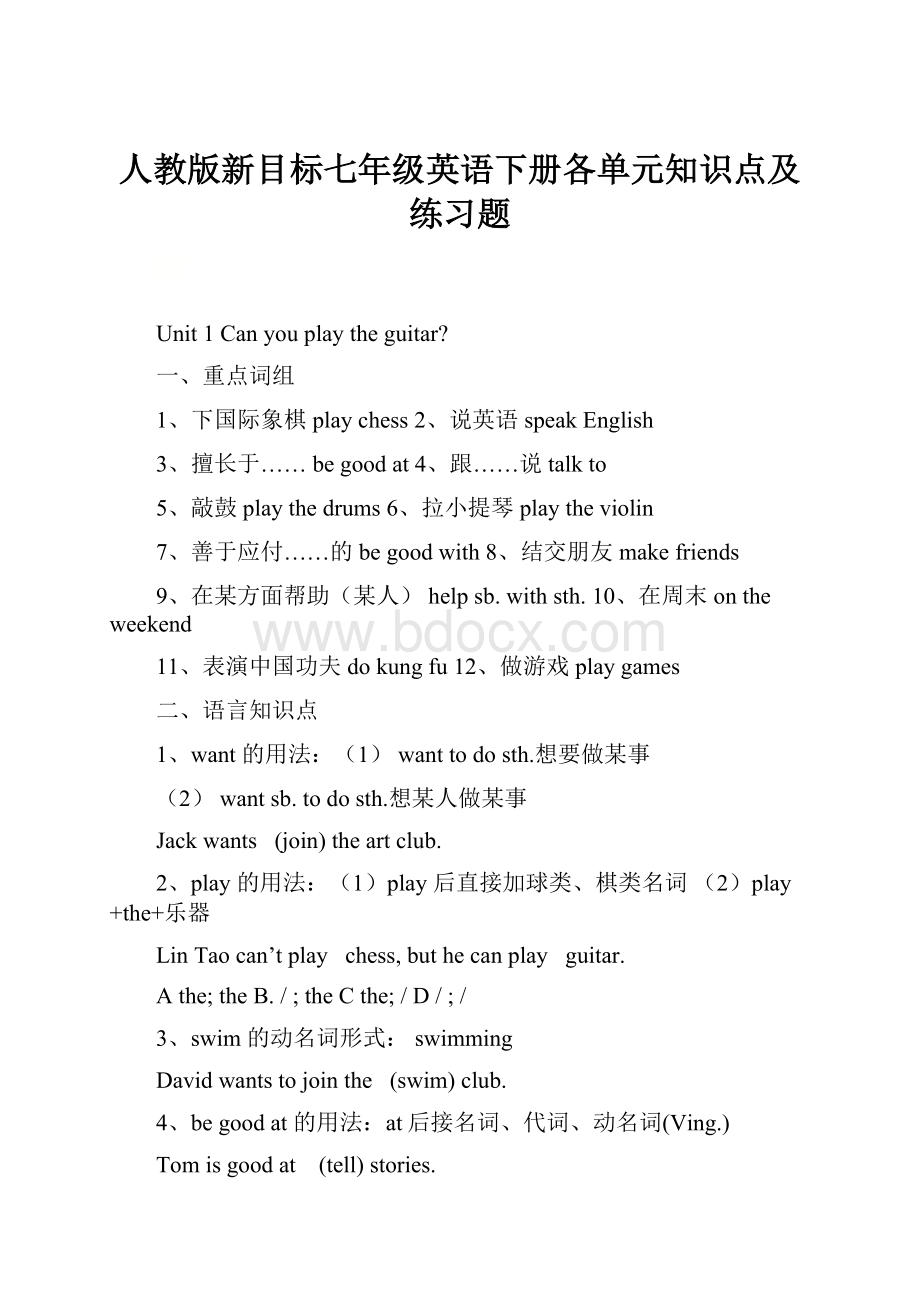 人教版新目标七年级英语下册各单元知识点及练习题.docx
人教版新目标七年级英语下册各单元知识点及练习题.docx
- 文档编号:10706308
- 上传时间:2023-02-22
- 格式:DOCX
- 页数:26
- 大小:32.46KB
人教版新目标七年级英语下册各单元知识点及练习题.docx
《人教版新目标七年级英语下册各单元知识点及练习题.docx》由会员分享,可在线阅读,更多相关《人教版新目标七年级英语下册各单元知识点及练习题.docx(26页珍藏版)》请在冰豆网上搜索。

人教版新目标七年级英语下册各单元知识点及练习题
Unit1Canyouplaytheguitar?
一、重点词组
1、下国际象棋playchess2、说英语speakEnglish
3、擅长于……begoodat4、跟……说talkto
5、敲鼓playthedrums6、拉小提琴playtheviolin
7、善于应付……的begoodwith8、结交朋友makefriends
9、在某方面帮助(某人)helpsb.withsth.10、在周末ontheweekend
11、表演中国功夫dokungfu12、做游戏playgames
二、语言知识点
1、want的用法:
(1)wanttodosth.想要做某事
(2)wantsb.todosth.想某人做某事
Jackwants(join)theartclub.
2、play的用法:
(1)play后直接加球类、棋类名词
(2)play+the+乐器
LinTaocan’tplaychess,buthecanplayguitar.
Athe;theB./;theCthe;/D/;/
3、swim的动名词形式:
swimming
Davidwantstojointhe(swim)club.
4、begoodat的用法:
at后接名词、代词、动名词(Ving.)
Tomisgoodat(tell)stories.
5、like的用法:
(1)likedoingsth.
(2)liketodosth.
6、and和or的用法:
肯定句中用and,否定、疑问句中用or
Ican’tsingdance.AandBorCbutD/
7、辨析say、speak、tell、talk
▲say是“讲,说”的意思,强调说话内容。
一般作及物动词,常用于直接引述所说的话或间接叙述所说的话。
▲speak作及物动词,意为“说”“讲”,其宾语常是某种语言。
▲talk意为“讲、谈论,谈话”,常用″talkto/withsb.″
▲tell意为“告诉,对……说”。
还专指讲故事,说谎。
常用作tellsb.sth./tellsth.tosb.或tellsb.todosth.结构。
Canyou_____English?
AsayBspeakCtalkDplay
Mygrandmaoftenstoriestous.AspeaksBtalksCsaysDtells
Wecanourfriendsafterclass.
AtalkBtalktoCtellDtellto
8、固定搭配:
和……玩……play…with…
9、busy的句型:
(1)bebusydoingsth.忙于做某事
(2)bebusywithsth.忙于某事
Mymotherisbusydinnerforus.
AmakeBmakingCtomake
10、also、too、either用法区别:
also位于句中,be、助、情后,实意动词前;too位于肯定句末,前用逗号隔开;either位于否定、疑问句末。
Peterplaysoccer.
AcanalsoBalsocanCcantooDtoocan
11、help的句型:
(1)helpsb.(to)dosth.帮助某人做某事
(2)helpsb.withsth.在某方面帮助某人
Areyougoodkids?
Weneedhelpmyson’sEnglish.
Aat;withBfor;withCwith;withDwith;at
12、teach的用法:
teachsb.(人称代词宾格)
WhoteachesEnglish?
AyouByourCyoursDour
13、join的用法:
join作“参加,加入”讲时,一般指参加某一组织、团体或某群人。
如:
jointheParty,jointhearmy,joinusinthetalk
14、can的用法:
情态动词,后接动词原形。
问句直接将can提至句首,肯定回答用can,否定回答用can’t.
Maybehecan_________________intheirbasketballteam.
AisB.beC.are
---Canyourmotherplaychess?
----.
AYes,shedoesBNo,shecan
CYes,shecansDNo,shecan’t
Unit2Whattimedoyougotoschool?
一、重点词组
1、起床getup2、穿衣getdressed
3、洗淋浴takeashower4、在周末onweekends
5、做作业doone’shomework6、散步takeawalk
7、要么……要么……either…or…8、大量;许多lotsof
9、去上班gotowork10、迟到belatefor
11、上床睡觉gotobed12、做运动playsports
二、语言知识点
1、对时间提问的特殊疑问词:
whattime、when
Lucygoestobedatnineo’clockintheevening.(对划线部分提问)
2、时间的读法:
(1)顺读:
钟点数+分钟数
(2)逆读。
有两种形式:
分钟数小于或等于30——分钟数past钟点数
分钟数大于30——分钟数(60减分钟数)to钟点数(钟点数加1)
其中,还有两个特殊时刻,15分钟是quarter(一个小时的四分之一),30分钟是half(一个小时的一半),其他时刻直接用数字。
8:
159:
239:
30
10:
4511:
38
3、介词in、on、at在时间前的用法:
in用于年、月前;on用于日前;at用于时刻前
Heoftenplaysping-pongfiveo’clockintheafternoon.
AatBinConDfor
4、固定结构:
从……到……:
from…to…
5、频率副词always,usually,never的用法:
always(一直)、usually(通常)、never(从不),be、助、情后,实意动词前。
Whattimedoesyourfatherup?
AusuallygetsBgetsusuallyCusuallygetDgetusually
Maryschool.
AisneverlateforBisneverlateto
CneverislateatDneverislatefor
6、job和work的用法区别:
job可数名词;work不可数名词
Lucy’sbrotherhas.
AainterestingworkBaninterestingjob
CainterestingjobDaninterestingwork
7、lotsof的用法:
许多、大量lotsof=alotof既可修饰可数名词,也可修饰不可数名词
8、“for”+一段时间的用法
Maryusuallyexerciseshalfanhourinthemorning.
AforBatConDin
9、三餐饭前用介词for。
Myfatherusuallyhasnotimebreakfast.
AtoBforCatDin
10、That’safunnytimeforbreakfast!
那个时间吃早饭真有意思哟!
time常常和介词“for”搭配,表示“做……的时间”。
Wedon’thavetoomuchtimesports.
AtoBforCwith
11、“对……有益;对……有好处”的结构:
begoodfor
“对……有害;对……有坏处”的结构:
bebadfor
12、taste的用法:
系动词,后常接形容词,构成主系表句子结构。
Thetealooksbad,butittastes.
AwellBbadCnicelyDgood
Unit3Howdoyougettoschool?
一、重点词组:
1、乘地铁takethesubway2、骑自行车rideabike(bybike)
3、每天everyday4、认为thinkof
5、在……和……之间between…and…6、实现cometrue
7、到达getto
二、语言知识点:
1、如何表达交通方式:
A、take+a/the+交通工具名次eg:
takea/thebus
B、by+交通工具名词eg:
bybusbybike
C、by+交通路线的位置表示“通过……途径”
eg:
bywater(从水路)byair(乘飞机)
D、in+限定词+交通工具名词in多用于封闭式交通工具
eg:
ina/thecar/taxi
E、on+限定词+交通工具名词on多用于开放式或半封闭式交通工具eg:
ona/thebus
F、表示“步行去某地”可用“goto+某地+onfoot”,也可用“walkto+某地”。
2、询问交通方式及回答的句型:
Howdoyougettoschool?
I…
3、询问花多费少时间及回答的句型:
Howlongdoesittake…?
Ittakes…
4、询问两地间的距离及回答的句型:
HowfarisitfromAtoB?
It’sabout…
---doeshegettoschool?
---Hegetstoschoolbybus.
AWhatB.HowC.WhenD.Why
---isitfromthebusstationtothetrainstation?
---It’sabouttwokilometers.
AHowlongB.HowC.HowsoonD.Howfar
doesittakeJimtohomebysubway?
A.Howfar;gettoB.Howlong;arrivein
C.Howlong;getD.Howfar;arriveat
5、exercise的用法:
作名词意思为运动、锻炼时为不可数名词;作名词意思为操、练习时为可数名词。
Runningisgoodexercise.A.aB.anC./
domorning(exercise)
6、“你认为……怎么样?
”的表达方式:
Whatdoyouthinkof…?
=Howdoyoulike…?
---doyouthefootballgame?
---Itiswonderful.
A.What;thinkofB.How;thinkofC.What;likeD.How;think
6、“做某事怎么样的”的表达方式:
It’s+形容词+todosth.
7、11-year-old和11yearsold的用法区别:
11-year-old11岁大的11yearsold11岁
NinaisEnglishteacher.
A.a22-year-oldB.an22yearsoldC.a22-years-oldD.an22yearold
Unit4Don’teatinclass.
一、重点词组:
1、在课堂上inclass2、准时ontime
3、听……listento4、拍照takephotos
5、外出goout6、清洗餐具dothedishes
7、整理床铺makeone’s/thebed8、考虑thinkabout
9、遵守规则followtherules10、(对某人)要求严格bestrictwithsb.
二、语言知识点
1、get、arrive、reach用法区别:
get+to+地点;arrive+in(大地点)/at(小地点);reach后直接加地点。
Tomhomeearlyeveryday.
A.getstoB.arrivesatC.arrivesD.arrivesin
2、bring、take用法区别:
bring…to…带来take…to…带走;
‘Pleaseyourhomeworktoschool.”Mr.Wangsays.
A.takeB.makeC.doD.bring
3、must,haveto的用法:
must情态动词,必须(主观愿望),以must开头的问句,肯定回答用must,否定回答用needn’t或don’thaveto;haveto不得不,必须(客观要求)
Samstayinbedforafewdays.Becausehislegishurt.(受伤的)
A.hastoB.havetoC.mustD.doesn’thaveto
4、practice+doing.
WemustpracticemoreEnglish.
A.speakB.tospeakC.talkingD.speaking
5、toomany:
太多(修饰可数名词)toomuch:
太多(修饰不可数名词)
muchtoo:
太
Therearepeopleinthehallandtherearenoise(噪音)init.
A.toomany;toomuchB.toomany;muchtoo
C.toomuch;toomanyD.toomuch;muchtoo
Therearerulesandworkinmyfactory.Ican’tstand(忍受)them.
A.toomuch;toomanyB.toomany;toomuch
C.toomuch;toomuchD.toomany;toomany
6、辨析read、see、watch、look:
read:
看/读书、报、杂志等see:
看见,看到
watch:
“观看”,指看电视、电影、节目、比赛等
look:
lookat+宾语看……强调看的动作
Marylikesstorybooks,butherbrotherlikesfootballgames.
A.reading;watchingB.seeing;lookingat
C.reading;seeingD.watching;seeing
7、strict的句型:
(1)bestrictwithsb.对某人严格要求
(2)bestrictinsth.对某事(某方面)严格要求
Theteacherisverystrictusourlessons.
A.at;inB.in;withC.with;inD.in;at
8、remember的句型:
(1)remembertodosth.记得要做某事(事未做)
(2)rememberdoingsth.记得做过某事(事已做)
Pleaserememberthedoorwhenyouleave.
A.tocloseB.closeC.closingD.closed
9、keep的用法:
keep+名词+形容词
Pleasekeepyourclassroomandtidy.
A.cleansB.cleaningC.tocleanD.clean
10、学会做某事:
learntodosth.
11、havefun+doingsth.=haveagoodtime
Wehavelotsoffungames.
A.playB.toplayC.playingD.plays
12、relax、relaxing、relaxed的用法:
relax,是动词
relaxing,形容词,主语是事情或是物,或者可以修饰名词“令人放松的”
例如:
Thetripisrelaxing.旅途是令人放松的
=Thisisarelaxingtrip.这是一次让人轻松的旅途。
relaxed形容词,主语是人,“轻松的,放松的”
例如:
Shefeelsveryrelaxed。
她感到很轻松。
Shelooksbecauseshehasavacation.(假期)
A.relaxed;relaxedB.relaxing;relaxing
C.relaxed;relaxingD.relaxing;relaxed
13、祈使句:
肯定结构:
动词原形开头否定结构:
句首加Don’t
playfootballonthestreet(街道).It’sdangerous.
A.PleaseB.Don’tC.DoD.Doesn’t
Tom,theclassroomrightnow.It’stoodirty.
A.cleanB.tocleanC.cleaningD.don’tclean
Unit5Whyareyoulikepandas?
一、重点词组
1、欢迎来到……welcometo2、有点儿kindof
3、来自……befrom=comefrom4、很,非常alot
5、迷路getlost=belost6、面临危险beindanger
7、脱离危险beoutofdanger8、砍倒cutdown
9、由……制造bemadeof10、对某人有好befriendlytosb.
二、语言知识点
1、let’s+动词原形;letsb.dosth.让某人做某事
Let’s.
A.gohomeB.gotohomeC.togohomeD.goinghome
Letus(sing)withyou.
2、why提问,回答用because
---doyoulikepandas?
---Becausetheyareverycute.
A.WhyB.WhereC.WhenD.What
3、Whydon’tyou……?
为什么不……(后接动词原形;=Whynot……?
)
Whydon’tyouyourparentsaboutit?
A.tellB.totellC.tellingD.tells
Whynottheswimmingclub?
A.joinB.tojoinC.joiningD.joins
4、用两条腿走路walkontwolegs
5、oneof…………之一,后接可数名词复数
Tonyis.
A.oneofmypenpalB.aofmypenpalC.onemypenpalsD.oneofmypenpals
6、forget的句型:
forgettodosth.忘记做某事(还未做)
forgetdoingsth.忘记做过某事(已做)
Don’tforgetfoodtothecat.
A.givingB.togiveC.giveD.gives
7、tree:
onthetree在树上(本身所有)inthetree在树上(外来物)
Thereisabird.A.onthetreeB.inthetree
8、over超过=morethan
9、危险(名词):
danger危险的(形容词):
dangerous
Theoldmanisbadlyill(病得严重).Heis.
A.ingreatdangerB.dangerousC.indangerousD.ondanger
Unit6I’mwatchingTV.
一、重点词组:
1、看报纸readanewspaper2、通过电话交谈talkonthephone
3、做汤makesoup4、去看电影gotothemovies
5、出去吃饭eatout6、客厅livingroom
二、语言知识点
1、现在进行时:
(1)、意义:
表示说话时正在进行或发生的动作;也可表示当前一段时间内的活动或现阶段正在进行的动作。
(2)、结构:
主语+be(am,is,are)+动词-ing形式+其它;
(3)、动词-ing形式的构成:
a、一般情况直接加–ing;
b、以不发音字母e结尾的动词,去e,再加–ing;
c、以重读闭音节结尾的动词,末尾只有一个辅音字母,先双写这个辅音字母,再加–ing。
(4)、标志词:
nowlooklisten
Listen,thegirlanEnglishsong.
A.singsB.singC.issingD.issinging
---WhatisMarydoing?
---.
A.SheiswashingthedishesB.Sheoftenwashesthedishes
C.She
- 配套讲稿:
如PPT文件的首页显示word图标,表示该PPT已包含配套word讲稿。双击word图标可打开word文档。
- 特殊限制:
部分文档作品中含有的国旗、国徽等图片,仅作为作品整体效果示例展示,禁止商用。设计者仅对作品中独创性部分享有著作权。
- 关 键 词:
- 人教版 新目标 年级 英语 下册 单元 知识点 练习题
 冰豆网所有资源均是用户自行上传分享,仅供网友学习交流,未经上传用户书面授权,请勿作他用。
冰豆网所有资源均是用户自行上传分享,仅供网友学习交流,未经上传用户书面授权,请勿作他用。


 1212中级汽车维修工考试试题三.docx
1212中级汽车维修工考试试题三.docx
